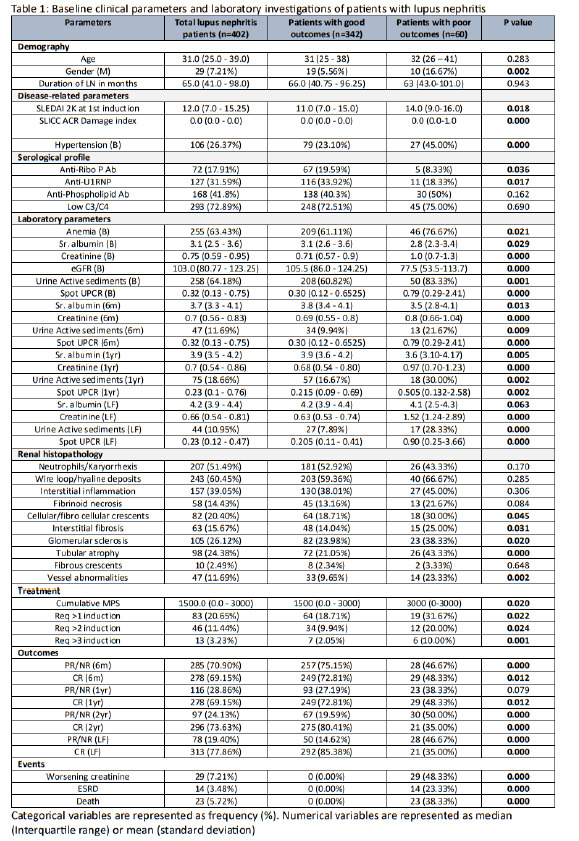Session Information
Session Type: Poster Session A
Session Time: 10:30AM-12:30PM
Background/Purpose: Lupus nephritis (LN) is a serious manifestation of systemic lupus erythematosus (SLE), with 14-33% failing to respond to standard treatments. This study assesses treatment outcomes and mortality among LN patients unresponsive to first-line immunosuppressive therapies.
Methods: The renal biopsy registry was screened for individuals with at least one biopsy between 2004 and 2023. Patients with class III, IV, and V LN at the first biopsy were included. We recorded demographic, clinical, laboratory, and histopathological features. A Bayesian Network (BN) model was used to predict outcomes, representing conditional dependencies between variables and estimating event probabilities. Five BN models were created for different outcomes: death, ESRD, PR/NR, worsening creatinine, and any event. Significant associations from univariate analysis were included in the final BN model. The Tree Augmented Naïve Bayes (TAN) algorithm was used for structure learning, while Maximum Likelihood Estimation (MLE) was used for parameter learning. Ten-fold cross-validation ensured model robustness, with sensitivity, specificity, PPV, NPV, error rate, and Gini coefficient assessed for predictive performance. BN modeling was performed using Netica 6.09.
Results: We identified 402 SLE patients (92.7% women) with biopsy-proven LN and complete records, with at least 2-year follow-up. Sixty patients had poor outcomes (worsening creatinine, ESRD, death). Of these, 31.6% received 2 inductions, 20% received 3 inductions, and 10% received >3 inductions. IV cyclophosphamide was used in 91.6% of first inductions, with mycophenolate mofetil in 8.3%. Complete remission rates for first, second, and third inductions were 11%, 0%, and 1%, respectively. Significant predictors of poor outcomes included elevated SLEDAI-2K scores, increased SLICC ACR damage indices, hypertension, anemia, and high serum creatinine levels. Low serum albumin and high UPCR at follow-up were also associated with poor prognosis.
Conclusion: This study demonstrates the utility of BN analysis in predicting DTT LN. Using the TAN algorithm, we constructed robust BN models that accurately estimate poor outcomes, including worsening renal function, ESRD, and mortality. Identified predictors are critical for early intervention and personalized treatment, improving patient management and outcomes in lupus nephritis.
To cite this abstract in AMA style:
K L J, Jose A, G V, S D, S D, Tokala S, Mashetty B, Kavadichanda C, ganapathy S, Gopal A, Roshan R, Reddy S, Mehra S, Thabah M, Negi V. Data-driven Bayesian Network Analysis for Predicting Difficult-to-treat (DTT) Lupus Nephritis [abstract]. Arthritis Rheumatol. 2024; 76 (suppl 9). https://acrabstracts.org/abstract/data-driven-bayesian-network-analysis-for-predicting-difficult-to-treat-dtt-lupus-nephritis/. Accessed .« Back to ACR Convergence 2024
ACR Meeting Abstracts - https://acrabstracts.org/abstract/data-driven-bayesian-network-analysis-for-predicting-difficult-to-treat-dtt-lupus-nephritis/



